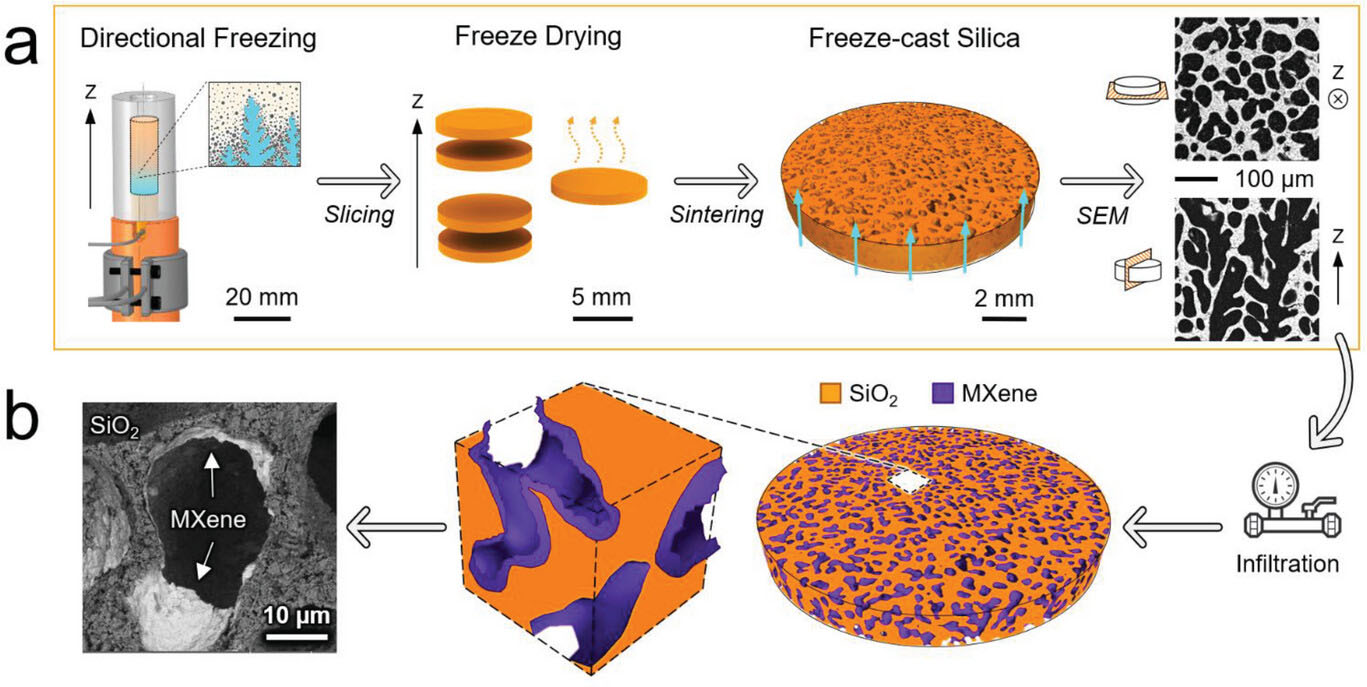| Oct 31, 2023 |
| |
|
(Nanowerk Spotlight) Two-dimensional materials like graphene and MXene have generated great excitement in recent years due to their exceptional properties, which hold promise for applications such as batteries, fuel cells and sensors. However, a major challenge has been assembling these nanoscale, atomically thin sheets into functional 3D structures. The sheets have a strong tendency to restack into dense films when assembled in 3D, severely limiting their performance. This restacking occurs because of strong van der Waals forces between the 2D sheets. It reduces the accessible surface area and blocks reactive sites, compromising properties like electrical conductivity and ion transport. Overcoming restacking to create porous 3D networks has been a persistent roadblock to progress.
|
|
Researchers at Carnegie Mellon University now have pioneered an entirely new hybrid material system. Their novel approach enables assembling 2D nanosheets into 3D interconnected networks for the first time. This overcomes a persistent challenge that has severely limited applications of 2D materials.
|
|
The team reports their findings in Advanced Materials (“3D Assembly of MXene Networks using a Ceramic Backbone with Controlled Porosity”).
|
 |
| Fabrication of electrically conductive porous silica via infiltration of 2D MXene nanosheets. a) Preparation of silica discs with unidirectional porosity via freeze casting. The blue arrows represent the solidification direction and the main pore orientation. The SEM images show the horizontal (top) and vertical (bottom) cross-sections of the fabricated porous samples (scale bar = 100 µm). b) A MXene infiltrated porous silica sample with a zoomed-in 3D figure showing the thin-layer coating of internal pore surfaces by MXene flakes while preserving the structural porosity. A high-magnification back-scattered SEM image of an infiltrated sample shows the thin-layer MXene coating (scale bar = 10 µm). (Reprinted with permission by Wiley-VCH Verlag)
|
|
The researchers’ innovative method involves creating a porous ceramic backbone using freeze-casting. This backbone acts as a scaffold to arrange MXene sheets in 3D configurations while preventing restacking. The team infiltrates the porous structure with a dispersion of MXene nanosheets, thereby creating an interconnected 3D network inside the ceramic backbone.
|
|
As the dispersion dries, capillary forces draw the MXene sheets onto the internal pore surfaces of the ceramic backbone, causing the sheets to conformally coat the pores in a thin layer. This configuration spreads the MXene sheets over a large surface area while keeping them separated.
|
|
This new material system could enable significant advances in energy storage, electronics, catalysis and more by finally overcoming the major barrier of assembling 2D nanomaterials in functional 3D architectures. The researchers already demonstrated substantially improved performance for supercapacitor energy storage using their novel approach.
|
|
Using this method, the researchers were able to produce samples with MXene coatings on up to 99% of the available pore surface area. They demonstrated electrical conductivity over 300 times higher than typical values for porous ceramics like silica.
|
|
Critically, the team showed they can control the architecture of the 3D MXene network by tuning parameters like the backbone pore size, MXene concentration and number of infiltration cycles. This ability to tailor the nanostructure enables optimizing performance for different applications.
|
|
To highlight potential uses, the researchers constructed symmetric supercapacitors using their MXene-infiltrated porous silica electrodes. They achieved a remarkable areal capacitance exceeding 7 F/cm2 despite minimal MXene mass loading of only 2.4 mg/cm2.
|
|
The supercapacitors also delivered a high areal energy density of 0.3 mWh/cm2, comparing favorably to literature values for other MXene-based devices. These results suggest substantially improved MXene utilization efficiency with the 3D configuration compared to conventional planar electrodes.
|
|
Looking ahead, the team’s novel fabrication method could bring transformative changes in electronics, energy and catalysis by overcoming the bottleneck of assembling 2D materials in 3D. Their supercapacitor findings already point to potential leaps in integrated energy storage.
|
|
In energy applications, the combination of high surface area and 3D interconnected channels could greatly increase reaction rates for fuel cells, flow batteries and catalytic systems. For electronics, adeptly controlling the 3D architecture and connectivity of 2D nanosheets may open new possibilities in computing and sensing.
|
|
An intriguing aspect is that the approach can likely be extended to other 2D materials like graphene as well as other porous scaffold materials. While the study used MXene and silica, the concept could have broad applicability.
|
|
By providing a solution to the restacking problem, the research represents an important step toward fully harnessing the promise of 2D materials. Evidence already shows that transitioning from 2D to controlled 3D configurations significantly boosts performance.
|
|
Looking forward, this strategy for assembling 2D nanosheets in functional 3D networks could lay the foundation for advances across much of science and technology. Many future applications will depend on adeptly structuring matter on the nanoscale in all three dimensions.
|
|
This new method offers a versatile yet simple fabrication route for designing 3D nano-architectures tailored to application needs. If the approach lives up to its potential, it could accelerate development of innovative energy, electronics, filtration, sensing and therapeutic technologies.
|

By
Michael
Berger
– Michael is author of three books by the Royal Society of Chemistry:
Nano-Society: Pushing the Boundaries of Technology,
Nanotechnology: The Future is Tiny, and
Nanoengineering: The Skills and Tools Making Technology Invisible
Copyright ©
Nanowerk LLC
|
|
|
- SEO Powered Content & PR Distribution. Get Amplified Today.
- PlatoData.Network Vertical Generative Ai. Empower Yourself. Access Here.
- PlatoAiStream. Web3 Intelligence. Knowledge Amplified. Access Here.
- PlatoESG. Carbon, CleanTech, Energy, Environment, Solar, Waste Management. Access Here.
- PlatoHealth. Biotech and Clinical Trials Intelligence. Access Here.
- Source: https://www.nanowerk.com/spotlight/spotid=63970.php





